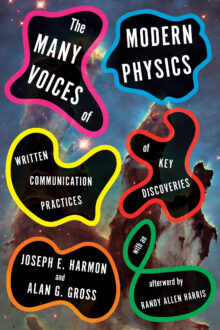

Alan G. Gross
Alan G. Gross was professor emeritus of rhetoric in the Department of Communication Studies at the University of Minnesota, where he was a founding faculty member of the Rhetoric and Scientific and Technical Communication graduate program. He also was a visiting fellow in the Center for Philosophy of Science at the University of Pittsburgh and held appointments at several international universities. He was a prolific author of dozens of articles and author, coauthor, or editor of more than a dozen books in rhetorical theory, rhetorical criticism, and the rhetoric of science. He was named a Distinguished Scholar by the National Communication Association in 2014.
Photo by Sarah R. Gross
The Many Voices of Modern Physics
Written Communication Practices of Key Discoveries
The Many Voices of Modern Physics follows a revolution that began in 1905 when Albert Einstein published papers on special relativity and quantum theory. Unlike Newtonian physics, this new physics often departs wildly from common sense, a radical divorce that presents a unique communicative challenge to physicists when writing for other physicists or for the general public, and to journalists and popular science writers as well. In their two long careers, Joseph Harmon and the late Alan Gross have explored how scientists communicate with each other and with the general public. Here, they focus not on the history of modern physics but on its communication. In their survey of physics communications and related persuasive practices, they move from peak to peak of scientific achievement, recalling how physicists use the communicative tools available—in particular, thought experiments, analogies, visuals, and equations—to convince others that what they say is not only true but significant, that it must be incorporated into the body of scientific and general knowledge. Each chapter includes a chorus of voices, from the many celebrated physicists who devoted considerable time and ingenuity to communicating their discoveries, to the science journalists who made those discoveries accessible to the public, and even to philosophers, sociologists, historians, an opera composer, and a patent lawyer. With their final collaboration, Harmon and Gross offer a tribute to the communicative practices of the physicists who convinced their peers and the general public that the universe is a far more bizarre and interesting place than their nineteenth-century predecessors imagined.

